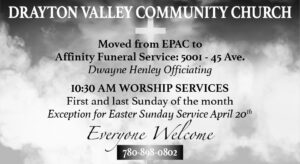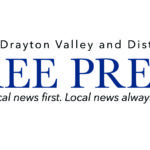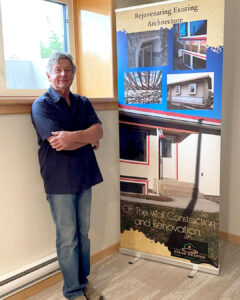In an effort to increase the ability of the RCMP to investigate small crimes such as vandalism, RCMP are inviting Drayton residents and businesses to register their home cameras with them.

Church of God
Drayton Valley Church of God. Our Worship Services usually include: traditional hymns, praise choruses, and contemporary songs, prayer, scripture, and a sermon.

Life Church Drayton Valley
We know that exploring a new church can be an overwhelming experience. To help you

St. Anthony Catholic Church
St. Anthony’s Parish Drayton Valley. Weekend mass Saturday and Sunday
A media package released by the RCMP says that the goal is to be able to increase the amount of information that is available to them. Once a person has registered their camera with the RCMP, it will allow the police the opportunity to quickly see which cameras are available in the area where a crime has taken place.
While the package says that door to door checking after a crime will still happen, if the cameras are registered, it may help in getting additional information such as license plate numbers.
An all Canadian team that included a local resident was able to win the rodeo for the first time in the history of the World Famous Miles City Bucking Horse Cowboy Mardi Gras.
Wilfred Titanich was one of a team of three that attended the three-day event in Miles City, Montana from May 15-18. Titanich along with two brothers, Cory and Cody Loken, were the first all Canadian team to win at Bucking Horse since the first Miles City Bucking Horse Sale started in 1951.
Each member of the team came home with around $7,500 US, says Titanich.
“We got Championship Buckles and we got Championship Holders, too,” he says.
The team participated in the Wild Horse Racing event, which involves at least three people and an untouched horse. The horse starts out in the bucking chute and two members of the team follow the horse out, holding onto a long lead. One person is the mugger, and their job is to control the horse’s head by covering its eyes with his arm, which calms it and prevents it from rearing and hurting someone. The shanker holds onto the rope so it doesn’t run away. The rider saddles it, mounts, and holds on tight as they race to the finish line on a wild horse.
“Wild Horse Racing is one of the oldest events in rodeo,” says Titanich.
Though the event is called Wild Horse Racing, the horses used in the event are owned, but untouched.
Throughout the year, Titanich works the Canadian Wild Horse Racing Association Circuit, spending most of his time in Alberta, but also attending some events in B.C. and Saskatchewan, where he competes in both amateur and pro rodeos.
“Honestly, it’s really addicting,” says Titanich. “It looks really crazy, and it is pretty wild, but it’s super addicting. It’s an adrenaline rush in sport.”
He says he would encourage people who like competitive events to try Wild Horse Racing.
The Loken brothers have both been in the sport for about 15 years, says Titanich. Both of them were about 14-years-old when they first started out. Titanich has been in the sport for three or four years.
Normally, the Lokens race with their dad, Jason, and Titanich has his own team. But the three of them thought it would be fun to head down to Miles City for some fun.
The Bucking Horse Sale was a stand-alone event, says Titanich. His team is getting ready for the circuit this summer.
“We can rodeo every weekend from now to the end of October,” he says.
Anyone looking for information about which wild horse racing rodeos are coming up can visit www.wildhorseracing.ca. Titanich says he will be in Brooks at the Lea Park Rodeo this weekend and in Killam for the Killam Rodeo that will be held outdoors in Sedgewick this year.
From Oklahoma to Keystone: Uncovering Hidden Histories at the Breton Library
An author who has written a non-fiction book that ties the Breton area to a mysterious child in Oklahoma will be visiting the Breton Library on June 7.
Russell Cobb, author of Ghosts of Crook County: An Oil Fortune, A Phantom Child, and the Fight for Indigenous Land is a Professor of Modern Languages and Cultural Studies at the University of Alberta. He was invited to the library by the Breton Library Board and the Breton Museum.
Allan Goddard, the manager of the Breton Museum, says he met Cobb when the author was working on the manuscript for the novel.
“He came out to the museum because there is a connection to the Hooks family,” he says.
Goddard says while the book does have some history about the Keystone area, and some relatives that may still live in the area, it is mainly about what indigenous families had to deal with in the early 1900s in Oklahoma.
Claire Sather, the Chair of the Board of Trustees for the Breton Library, says she read the book after finding it on Goodreads, a social media site dedicated to book ratings and reviews.
She says when she got to the end and saw a familiar name, Brandy Fredrickson, it really registered how close some events in the book are tied to the area.
Goddard says when Jim Crow laws came into being in Oklahoma, it triggered an exodus of African Americans from Oklahoma to seek out refuge in Canada. A group of those immigrants settled around Breton in the Keystone area in the early 1900s.
The book centres around a child named Tommy Atkins, whose existence has never truly been proven, and the oilmen who were snatching up indigenous lands in Oklahoma. Goddard says one of the women rumoured to be Atkins’ mother lived in Keystone for a while before returning to Oklahoma.
Both Sather and Goddard are excited to have him visit the Library, however, the space is limited. Those who wish to attend the event on Saturday, June 7th at 1 p.m. have to pre-register to ensure they get a spot.
Those who are interested can register by calling the library at 780-696-3740 or send an email to bretonlibrary@yrl.ab.ca.
Cobb has also written The Great Oklahoma Swindle: Race, Religions, and Lies in America’s Weirdest State.
VE Day at 80: How World War II Is Fading from Living Memory
Eighty years ago this week a group of men gathered in a room in Berlin to sign a piece of paper which brought an end to six years of war in Europe.
It was one of the most significant turning points of the last 1,000 years. It’s an event which will be remembered as well as any in the history of humanity. But history is very much what it is becoming.
World War II will never be forgotten, but it is rapidly becoming little more than a memory.
Anyone involved in the actual fighting would be, at the very least, in their mid-90s. Today the median age in Canada is somewhere around 40. That means the war belongs more to our grandparents’ generation than to our parents’. We’re now approaching the point where no one alive will remember World War II .
Sad as that may seem, it’s part of the inevitable ebb and flow of human events. Things move on. No one today mourns the 65,000 who died at the Battle of Waterloo or those who lost their lives at a thousand other places from Thermopylae to Gettysburg. Instead we are more likely to dress up as them and re enact the events of the day, for reasons that, I must confess, have never been entirely clear to me.
And so it will be with World War II. Certainly the events 25 years earlier at Ypres, the Somme and Passchendaele have now taken on a sepia tinge. They have gone from being a horrendous bloodbath to a historical curiosity.
Time moves on. It’s a natural process and not something we could reverse even if we wanted to.
Years ago I worked with a copy editor who would indignantly write “which one?” in the margins of any news story that simply referred to “the war.” At the time I thought he was a bit of a dickhead. But now, well, I’m still pretty sure he was a dickhead, but he may have been a dickhead with a point.
The world has been far from peaceful since May of 1945. For one thing, the war in Asia was still raging on this day in 1945 and would not end for a few more months with the fall of Japan. But, also this week in 1954 the French were defeated by the Vietnamese in the battle of Dien Bein Phu. This week in 1960 the Soviet Union announced it was holding American U2 pilot Gary Powers. This week in 1999 NATO accidentally bombed the Chinese Embassy in Kosovo. And if you checked the news this morning you probably saw that war continues in Ukraine. Tragedy is continuing to unfold in Gaza. And, well, you get the picture.
Still, by asking “which war” my former colleague may have been a little bit ahead of his time. When someone mentions “The War”most of us will immediately think of 1939-1945.
But time will prove my copy editor’s point. Events, even the most important events in the world, gradually fade into history.
It won’t happen overnight, but make no mistake, it will happen. The process is already under way.
Drayton Valley looks at rural wealth creation
In partnership with the University of Alberta’s Community University Partnership (CUP) town council will be looking at different ways that Drayton Valley residents can work to generate local wealth for the community.
Geraldine Cahill, the director of UpSocial Canada who works with CUP, along with Dr. Maria Mayan from the U of A, spoke to council about initiatives that other municipalities have taken on to help stimulate local economies.
CUP has been working in Drayton Valley since 2020, when they helped the Town develop the Zero Fee Tuition Program, now called the Tuition Assistance Bursary. The partnership was developed for a research project to explore whether the ZFT program could be a mechanism for an inclusive economy.
“The results so far have been very positive, both on employment and also for quality of life for participants,” said Cahill.
Cahill told council they had engaged with stakeholders during the research and found a strategy that they would like to explore with the Town. They believe that Rural Wealth Creation could be an effective initiative to help Drayton Valley navigate increased costs in a way that can benefit the entire community.
“Across the country there has been a pattern of downloading costs and responsibilities to municipalities… without much change in capital transfers,” said Cahill. “That puts a great deal of strain on municipal governments and single-resource towns have been hard hit by this.”
With RWC, the Town would work together with residents to develop ways that residents can invest in community projects as part of their retirement, thus ensuring a larger chunk of local money stays in the municipality.
Over the past few years communities across the country have achieved economic stability by using programs such as co-operatives, local procurement, employee ownership and other succession models, community bonds, community land trusts and more. Cahill also provided examples from some of the municipalities that have gone in this direction.
In 2002, the municipality of Westlock learned that their grain terminals were going to be sold. As agriculture was one of the important sectors for the community, there was concern about how the sale could affect the local economy. So, instead of letting the grain terminals go, the community worked together to raise $1.2 million to purchase the grain terminal.
Those who invested in the terminal now get yearly dividends for their investment. They also have the most profitable terminal for its size in Canada and are planning on diversifying into a transport company.
Cahill says that the size of the municipality may play a role in which type of community program would work best.
Mayor Nancy Dodds asked Cahill how the Town could move forward with the plan as they would have to play a role in whatever path residents choose to move forward with.
“As the Town, as leaders, we want to be involved, but we don’t want to be getting in the way,” said Dodds. “How do you make sure that everyone has their say when you’re picking that.”
CUP has a workshop planned for May 5 at Clean Energy Technology Centre to help brainstorm some ideas that may work in the community. Cahill says everyone is welcome to attend and they will be looking at community assets as well as asking attendees what their priorities are.
Cahill says once they get some feedback from the meeting, she can use those priorities and ideas to generate profiles of which programs could best address them and how it would affect the community.
“Then we can shop them around for several months,” says Cahill. “I don’t want to rush the process so that people have a chance to weigh in.”
60 years strong: St. Anthony School plans celebration and future growth
In January 1965, the St. Anthony School opened its doors. Now, 60 years later, the school is planning a celebration of the milestone.
Principal Janelle Molzan says they are planning to have a celebration on May 24 at the school gym. They will be using the event to also fundraise for the school.
Molzan says they will have a band performing that evening, catering from a local restaurant, a full cash bar, as well as some door prizes.
Part of the celebration will also be the fact that St. Thomas Aquinas Roman Catholic School Division has put St. Anthony at the top of their priority list for a new school. Molzan says the division has to wait until next year to submit their request to the Province, and there is no guarantee that they will be selected for funding.
“It could be anywhere from two to ten years,” she says. “Or more.”
However, she feels that St. Anthony has a strong case for asking for a new school.
The most recent remodel of the school was in 1992, says Molzan. At that point they expanded the school, removing the gym from the centre of the school and installing classrooms instead. The new gym was then built as an addition to the school.
“We had the addition of the gym as well as a few classrooms in 1992,” says Molzan.
Since then, there have been no major remodels or renovations. Instead, the staff have been doing what they can to keep the building in shape.
“It’s a really well built school,” says Molzan.
She says over the years, the natural heaves and settling that occur with temperature fluctuations has led to some cosmetic damages to the building. “It’s just showing its age,” she says.
While the school is starting to show wear, Molzan says there are no capacity issues. About 15 years ago, the school went from being a K-12 school to a K-8 school when the Holy Trinity Academy was built.
Molzan says if they don’t get a new school they will have to pursue getting more renovations or remodeling for the current building.
New trespassing program helps businesses
Businesses will now have another option for dealing with trespassers thanks to a new program that Enforcement Services have put into place.
Cody Rossing, the manager of enforcement services and emergency management for the Town, says one of the biggest challenges for businesses in the community who were issuing trespass notices is that someone has to attend court in order for the trespassing charge to stick. With the new Trespassing Agent program which comes into place on March 20, businesses who enrol will not have to attend court.
Previously, businesses who contacted the RCMP to report a trespasser had to issue the trespass notices themselves.
For many businesses the process didn’t work well. Larger franchises, like banks, found arranging the issue of a trespass notice and attending court was not logistically feasible. Small business owners, on the other hand, could issue the notice but may have to close their business in order to attend court.
Rossing says there are two different pieces of legislation that speak to trespassing, the Petty Trespass Act and the Trespass to Premises Act.
“Under both of the legislations, the property owner or their agent are required to provide trespass notices, help get people off of their land, and stuff like that,” says Rossing.
The first offence fine under the provincial legislation is normally $600, but it could be up to $10,000. A second offence could have a fine of up to $25,000
The higher fines come into place when the individual ignores the notice and returns to the property. If the trespasser returns three times, the officers can then issue a summons to court. If they fail to attend, a warrant is issued, and at that point if they are found guilty, the higher fines can be given.
Rossing says the program is helping streamline the process for businesses. If they choose to enrol in the program, it will allow peace officers or the RCMP to act as their agent and issue the notices. It also means the business owners won’t have to attend court.
“Court is scary for a lot of people, and we understand that,” says Rossing.
The purpose of the program is to improve the process because officers are continuing to get calls to the same place over and over and business owners or their employees are uncomfortable with the court process. Until now, there hasn’t been any way to address those issues.
“It’s been a lot of work on the back end because there is no follow up process in place and there is no trespass notice being issued,” says Rossing.
He says the hope is that by having this program in place, businesses can sign up and they can begin to address the issue more efficiently.
Several different municipalities in the province have a similar program in place, says Rossing. While developing the program, Rossing did research on other initiatives and reached out to other municipalities that had something similar in place. He says he wanted to be sure that he had everything in place before he announced the program in the community.
There are also checks and balances that have been worked into the program.
“If you’re trespassed from a local business, one of our officers shows up and says you’re trespassed for six months, if you don’t agree with it, you can appeal that process,” says Rossing.
He says there is also the option for the business owners to speak with the officer and reduce the amount of time the individual is trespassed for. In some cases, if the RCMP issue a notice that’s in effect for six months, a business owner may come forward and advocate for the trespasser if the individual doesn’t normally behave in that manner
“They can say, ‘This person is normally a good customer, but there is something going on with him right now. I think maybe a month would be more appropriate,’” says Rossing.
However, it is ultimately the final discretion of the officer.
Once a business is enrolled in the program, they will receive a sticker that they can place in a conspicuous area that is easily visible for officers. If they receive a call, the officer will know that they can issue the notice themselves rather than speaking to the owner and explaining the process that has to take place.
Rossing says enrolment in the program is free, and he encourages businesses to sign up if they are having consistent issues with people loitering or being a nuisance on their property. Those who are interested in enrolling can visit www.draytonvalley.ca/enforcementservices/trespassingagent and fill out the form. They can then email it in to enforcement@draytonvalley.ca or drop it off at the Town office.
The cameras that are registered must be able to record twelve hours of footage. Then, if a crime happens in the area, police may ask to see the footage.
Any personal information will be kept secure and not released to the public.
They also say that this is by no means a mandatory program. If businesses or residents wish to register their surveillance equipment it is completely voluntary. Anyone who decides at a later date that they don’t want to participate in the program any longer can ask to have it removed at any time.
With an increase in demand for the Drayton Valley Food Bank, volunteers are concerned the facility may not keep up for much longer.
Heather and Phil Bell, the vice president and treasurer respectively, have been with the Food Bank for several years. During that time they’ve noticed a concerning trend in the uptick of users.
So far this year, they have given out hampers to 2,275 people, a stark contrast to the 2023 number of 1,653. Last year was a record year for hampers and this year has blown it out of the water.
Alberta food bank sees increased demand
The Bells says a lot of the hampers are going to families who have parents that work.
“The Food Bank, I feel, is an essential service right now, considering the need,” says Phil. “It’s something that’s heavily relied on.”
If things continue the way they have been, they’re expecting to hand out 2,556 hampers by the end of the year.
“It’s not just a blip, either,” says Phil. “This is going to continue on.”
Phil says that though they’ve seen increased usage, the generosity of the community has continued to keep up with the demand. Between food donations from local stores and food drives, the food bank has already received around $270,000 of in-kind donations.
“We have such a generous community,” says Heather. “It’s amazing.”
Heather says they are grateful for the building they’re in and the Town’s generosity in letting them use it for free. She says the location is perfect because it allows people more privacy than a location in a busier part of the community.
“But we’re outgrowing the building,” says Heather. “We’re at the point with our freezer and fridge capacity that the building can’t take anymore fridges and freezers without upgrading the electrical system.”
Space is a challenge for Drayton Valley food bank
Fridge and freezer space are vital in the Christmas season. Heather says in the past, they’ve had to turn away donations of a side of beef because they don’t have the space. Some companies have set up freezers in their buildings and offered the extra storage. Some volunteers also store some items as well.
The Bells say a sea can or some other place where they could store dried goods would be extremely helpful, as well. As it is, they have to store enough food in their building for roughly 30 hampers each pick up day.
At the beginning of November, the volunteers changed their system, and now only offer hampers on Thursdays. Phil says one recent hamper day saw volunteers hand out 86 hampers in three hours.
Creating that many food hampers also has its challenges. There isn’t a lot of room to put the hampers together and organize them, though Heather says they’ve developed a good system. Volunteers are now prebuilding hampers with dried goods for different sizes of families. On pick up days, all they have to do is go to the fridge and freezer to top the hamper off, and it can go out the door.
Thanks to a grant from the Family and Community Support Services, the Food Bank now has a part-time employee that can help with a lot of the administrative tasks. However, some recent Standards of Excellence put forth by the Federal Government is putting pressure on them as well.
The Standards of Excellence requires all Food Banks to have certain policies and procedures in place if they want to continue to be registered with Food Banks Alberta and Food Banks Canada.
Heather says it’s a great idea in theory, but the 78 page document is a massive undertaking for a busy food bank run by volunteers. Their employee is working on some of the documents, but it’s still a challenge.
“A lot of them are great ideas, but for small food banks, it’s quite overwhelming to comply with that,” says Heather.
Originally, the food banks had until March 2025 to have everything in place, but after feedback, they’ve given the smaller food banks more time to work on it.
The Bells say there are many ways for the community to help out the food bank and they won’t turn down donations if they can help it. They have more volunteers who are going through the orientation and are grateful for the continuing generosity of the community.
Community members often perform their civic duties in a variety of ways; some vote, most pay their taxes, and some volunteer their time.
The initiative, This Is Drayton Valley (TIDV), is hoping to make it easier for residents to find ways they can volunteer in their community. They’ve launched an online platform, www.lets-volunteer.com, that helps connect organizations to residents who are looking for a place to volunteer their time.
Jessica Doucette, the chair of the Healthy Community Coalition, says the idea for the platform first began when the HCC were brainstorming ways to offer programs for the clients in the Youth Hub. The biggest obstacle was finding volunteers to help out with the programs.
“We came up with this idea about creating an online platform that would make it easier for people to access volunteer opportunities,” says Doucette.
She says at that time, they were mostly considering the Youth Hub and looking for younger volunteers. They felt that an online platform would be the best way to reach out to that demographic.
When Kickstand Alberta became the parent organization of the Youth Hub, they found more challenges. As they were a newer provincial body, they weren’t ready to take on the project for all of their Youth Hubs. Doucette says rather than scrap the idea, they decided to offer it to the larger community.
“We realized it was actually an issue for everybody,” she says.
Originally, they had approached the Chamber of Commerce, who had already tried to make a similar platform. But as the HCC works under the Red Cross, they were told it wasn’t appropriate for them to work with an organization that only represented businesses. They continued to look and finally connected with Ryan Fynn, one of the founders of TIDV, to bring the idea to life.
The platform has been active for a couple of weeks, now, and as of November 22, there were 14 volunteers and 12 organizations on the site.
Fynn says the platform is similar to dating websites, in that the volunteers input information into a profile and then they can be matched with an organization that would best suit them. He says volunteers are encouraged to list things they are passionate about, their relevant skills, experience as a volunteer, how much time they want to commit, and which days they are open to help. Organizations can search for volunteers based on those parameters.
“For an example, River Valley Players is looking for a part-time musical director,” says Fynn. “If a volunteer says they are passionate about music, they will be connected to them.”
Doucette says the platform can also help people connect with someone with specific skills. “We just recently did a survey through the community parenting coalition, and we found that there’s a large majority of people that are willing to share their gifts with others,” says Doucette. “We just don’t ask the right questions.”
Fynn says it would also work well for finding volunteers for events. By listing their events and indicating what’s all involved in the positions, residents with profiles can find them and help out.
An Edmonton man has been charged with attempted murder after an incident that took place near the Brazeau Dam last week.
Just before midnight on Saturday November 9, the Drayton Valley RCMP received a 911 call reporting possible shots fired near the dam. As members arrived, they received an update that a female had been shot by a man with a .22 calibre rifle. The suspect, who is believed to have been part of a group who had been hunting in the area, was arrested and taken into custody without incident. Officers administered first aid to the female victim, who was suffering from multiple gunshot wounds, until emergency medical services arrived on the scene. The female victim was transported to the University of Alberta hospital where she was listed in critical but stable condition.
Leomer Serios Valencia, 43, has been charged with attempted murder, using a firearm in the commission of an offence, pointing a firearm, assault and uttering threats. After a telephone bail hearing Valencia was remanded in custody pending an appearance in Drayton Valley court.
Corb Lund played the Eleanor Pickup Art Centre stage for a raucous sold-out audience Thursday evening.
The Hurtin’ Albertans acoustic duo backing Lund were Grant Siemans on guitar and Sean Burns playing upright bass About a quarter of the 224 capacity seats were purchased as VIP tickets. At 5PM, the three front rows were filled as a solo Corb Lund was greeted with cheers, sat on the edge of the stage, and began singing VIP favourites, telling backstories and conversing. After the warm and friendly performance, knowing their seats were reserved, VIPs ticket holders shopped for merch in the EPAC lobby or went for a meal and refreshment to a downtown restaurant.
Several VIP super-fans commented that it was well worth the premium to be up-close and personal with Lund.
EPAC’s doors remained open as rush seating meant coming early for a preferred perch. The merch table was double-staffed as demand was high for CDs and vinyl LPs, “It’s Better with Cows Around” hoodies and Lund album cover poster three-packs. Lots of stock meant no one was disappointed. Long before the 7:30 curtain it was rare to find two seats together, however. A group of five young men just arriving before the curtain were quickly ushered to the remaining seats.
With the theatre full, an excited ambiance and the clock ticking down to showtime, it was no surprise that when the house lights dimmed, introduction completed, and Corb Lund with the Hurtin’ Albertans appeared from stage right, pandemonium reigned.
Joyful hoots and hollers, cheers, yahoos and multiple long, wavering, high-pitched vocal trilling filled the auditorium. The band, looking fresh and ready despite being midway through a long tour of Europe/US started what was only their second performance of this acoustic set.
The show opened with two songs from Lund’s 2007 Horse Soldier Horse Soldier album. The opening bars of the title track were greeted with cheers of recognition and rewarded with loud applause as was “Especially A Paint”. The set list dipped into Lund’s deep catalogue from a long career: “May you Always have Cows Around” (Cabin Fever 2012), “Devil’s Best Dress” (Losin’ Lately Gambler 2009), “Truth Comes Out” (Hair in My Eyes Like a Highland Steer 2006) and “The Cardplayers” ( El Viejo 2024).
A tribute to the late Ian Tyson included past collaborations and Tyson songs: “Someday Soon” (1964), “The Rodeo’s Over” (Hair in My Eyes…2005), and “La Primera” (Ian Tyson Lost Herd 1999). Many fan favourites peppered the performance. Prior to the intermission we were treated to “Hard on Equipment”, “This is My Prairie” , and “Big Butch Bass Bull Fiddle”. After the break, Lund introduced his next two songs as “hillbilly music” which drew cheers of anticipation. “Family Reunion” brought out the banjo and it stayed out for “Truck Got Stuck”, “Rye Whisky, Rye Whisky” and “Time to Switch to Whisky” . The audience sang backup for both. They even performed a verse and chorus “a capella” after which Lund said “buy a t-shirt, cuz we bought too many, thanks and goodnight!” But the EPAC audience was not yet ready for their good times to end. After lengthy applause, hoots and hollers, and a prolonged chant of “Corb, Corb, Corb” finally earned them their encore: a Lund solo of “S Lazy H”. It’s a plaintive ballad chronicling a family’s loss of their sixth generation ranch. The lyrics, “I have lived with the sorrow/And I will die with the shame/For now the bank owns what’s left/Of the S Lazy H” clearly tugged at the audience’s hearts. When the Hurtin’ Albertans rejoined Lund onstage, cheers banished melancholy as “Five Dollar Bill” was warmly welcomed and earned another standing ovation fitting for a memorable evening of great melody, lyrics and artistry.
I talked with Corb Lund backstage shortly after the final song and asked him how his evening was.
“It was super fun! It’s a cool little theatre. I like it!…
We were just in Europe. I think they find cowboy stuff exotic. Europeans like that about us. I know about Alberta and our regional culture, so people here pick up on the subtleties more. It’s a little different here cause people know what I’m talking about. I grew up just outside of Taber/Cardston, so I’m pretty used to small town Alberta life.”
I asked him about the set. “It’s only the second night we’ve been doing this acoustic trio, but it’s been really fun. It’s kind of different from the big loud band. I like that too, but it’s been kind of neat because there’s a lot of space to play with. Like the guys, especially Grant (lead guitar), when he’s playing his acoustic instruments there’s so much space in the theatre for it to speak. This was a blast. Thanks for having us.”
Grant Siemans has been playing with Corb Lund for 21 years. Lund gave him props explaining that any instrument he (Epiphone guitar) and Sean Burns don’t play, Grant does! I asked Siemans to expand. He listed off what he used for this acoustic trio set. “The mandolin is a Gibson F5 that’s actually Corb’s. It’s about 10 years old. It sounds awesome! The resonator is a 1931 National. I got a steal of a deal with that one because somebody painted it brown in the 1940’s. Nobody wanted it, which was awesome! It looks baaad! The banjo; Epiphone gave us. It was a new model. I asked him about the unique guitar and playing style Siemans used for most of the evening’s performance. “That’s a Manouche guitar (gypsy jazz guitar), a Djanko Rhinehart style guitar. It was made by a Winnipeg luthier named Al Beardsell, Beardsell Guitars.” The acoustic trio has no drum kit, so Siemans played manouche guitar Le Pompe style and imitates the drum kit’s cymbals, keeping rhythm and also the chording of the melody. “I like the playing, practicing, learning. It’s not work for me.”
Pleasant duty, indeed. Especially for the night’s audience!
Businesses will see some changes to the local Rural Renewal Stream program come into effect on November 13.
The program, offered through the Alberta Advantage Immigration Program, allows business owners to bring in skilled workers from outside of the province or country. It also allows business owners who employ staff on a Temporary Work Visa to endorse them for permanent residency through the program.
At the October 30 town council meeting, Kundiso Nyambirai, the growth services manager, explained that they had 300 applications that they were reviewing. Between March 2023 and August 2024, the Town had endorsed 200 of those applications for consideration to the Province.
Nyambirai explained that the Province has now put a system into place to make it easier to sort through the applications on their end.
The points based system gives a better idea of which applications are most likely to be considered or approved for those municipalities endorsing them. Nyambirai says his department is reviewing the applications to see which ones would have enough points to be considered by the Province.
However, the Province is limited in the number of applications that it can put through. There are more than 70 municipalities and districts participating in the program, and the Province only has 1,900 spots they can approve in 2024.
“We are over-subscribing,” says Nyambirai. “We are endorsing 200 plus people.”
In August, the Town decided to make some changes to the way that the program would work in the community. This included limiting the number of applications to 100 each year, while also limiting the number of applications a business can submit to five. Nyambirai also suggested that limiting applications to workers who already resided in the community could help to ensure that the Town does have housing available for these applicants.
Nyambirai says the Province is currently sorting through 1,000 applications to decide on the remaining spots for the year. Councillor Monika Sherriffs agreed that the Town is sending in a higher than average amount of endorsements, stating that if there are 1,000 being considered and Drayton Valley has sent in 200, then we would be sending in many more applications than other municipalities.
Councillor Amila Gammana disagreed, saying that he believed other communities are likely doing the same. He says the real question is how many of those endorsements are receiving approval from the Province.
Nyambirai says that the municipalities are not made aware of which endorsements are approved. He says that looking into that number by contacting applicants would be very time consuming, so they cannot be sure how many of Drayton Valley’s businesses’ applications have been accepted for the program.
Sponsored Content
In the age where there’s a constant drive for more and more content, coming up with ideas of how to promote your business can become a full time job on its own. I mean – you signed up to be a business owner right? Not a videographer, copywriter, or graphic designer. The good news is print advertising works differently from the social platforms that have you constantly chasing the next batch of likes and shares.
Print advertising with your local newspaper gets you off the hamster wheel and connects you with a copywriter, graphic designer, and an ad planner who are actually interested in learning the ins and outs of your business. This person or people will work with you to generate creative ideas within your marketing budget. With their help you can get your creative juices flowing again and find ways to not just push content but to craft creative content that will be seen and prompts action.
Print ads are consumed like fine wine. Readers look at print ads longer and deeper than they do the disruptive advertising found on other media platforms. Tell me in the last time that you’ve binge scrolled your social media feeds – How many ads do you actually remember seeing? I am betting, not many.
Print ads are non-disruptive content for newspaper readers and therefore get the attention they truly deserve. They have a longer lasting impact for readers, and after all, deepening the relationship with customers is really what you are looking to do.
So here are some ways you can position your local business with print advertising.
- Thought leadership: Be a thought leader in the regional landscape of your industry. Use an ad space for how-to content, data presentation on regional trends. Newspaper readers are readers and so are more likely to read long form advertisements with interesting information. You can reuse this information on your website blogs, social platforms, podcasts and the like.
- Be action oriented: Ads are there to move the needle forward. A call to action can be as simple as moving an interested person from the print ad to “Check out our online store” – print to digital is easy to do in both the print and digital formats of your local newspaper. Using click through options and QR codes to specific URLs makes the cross over from print to digital platforms seamless.
- Event marketing: Discovering local events in the community newspaper is one of the top interest points for local readers. But don’t just churn out a generic “Come to our event”. Remember our readers enjoy spending time with the paper. Capitalize on that. When you advertise an event in the newspaper you have an opportunity to make an intimate connection so don’t treat it like a fly by night ad. Make it engaging, personal, and relevant.
- Coupons and promotions: If you are a retailer or a restaurant that has deals and promotions, newspaper readers take notice! Not only does the use of coupons help you track the effectiveness of your ad it also gets people in the door where you can start to deepen your client relationship.
- Minimize or maximize. When people book a print ad they tend to want to throw everything into it. This creates a cluttered, hard to read ad. Instead take the space to promote your one product or service that tends to get people in the door, then cross promote once you are in contact with your prospective client. Alternatively you can also use the space to create an organized product catalogue, or flier page that showcases a number of products but in an organized and thematic fashion.
By contacting your local newspaper you don’t just get an ad, you expand your marketing team exponentially. You get access to our professionals and we help you to figure out the direction you are looking to go with your business.
Anyone looking for more information about the program can contact the RCMP at KDraytonValleyCamera@rcmp-grc.gc.ca.
At the time of the publication, there was no available comment from the RCMP.
With an increase in demand for the Drayton Valley Food Bank, volunteers are concerned the facility may not keep up for much longer.
Heather and Phil Bell, the vice president and treasurer respectively, have been with the Food Bank for several years. During that time they’ve noticed a concerning trend in the uptick of users.
So far this year, they have given out hampers to 2,275 people, a stark contrast to the 2023 number of 1,653. Last year was a record year for hampers and this year has blown it out of the water.
Alberta food bank sees increased demand
The Bells says a lot of the hampers are going to families who have parents that work.
“The Food Bank, I feel, is an essential service right now, considering the need,” says Phil. “It’s something that’s heavily relied on.”
If things continue the way they have been, they’re expecting to hand out 2,556 hampers by the end of the year.
“It’s not just a blip, either,” says Phil. “This is going to continue on.”
Phil says that though they’ve seen increased usage, the generosity of the community has continued to keep up with the demand. Between food donations from local stores and food drives, the food bank has already received around $270,000 of in-kind donations.
“We have such a generous community,” says Heather. “It’s amazing.”
Heather says they are grateful for the building they’re in and the Town’s generosity in letting them use it for free. She says the location is perfect because it allows people more privacy than a location in a busier part of the community.
“But we’re outgrowing the building,” says Heather. “We’re at the point with our freezer and fridge capacity that the building can’t take anymore fridges and freezers without upgrading the electrical system.”
Space is a challenge for Drayton Valley food bank
Fridge and freezer space are vital in the Christmas season. Heather says in the past, they’ve had to turn away donations of a side of beef because they don’t have the space. Some companies have set up freezers in their buildings and offered the extra storage. Some volunteers also store some items as well.
The Bells say a sea can or some other place where they could store dried goods would be extremely helpful, as well. As it is, they have to store enough food in their building for roughly 30 hampers each pick up day.
At the beginning of November, the volunteers changed their system, and now only offer hampers on Thursdays. Phil says one recent hamper day saw volunteers hand out 86 hampers in three hours.
Creating that many food hampers also has its challenges. There isn’t a lot of room to put the hampers together and organize them, though Heather says they’ve developed a good system. Volunteers are now prebuilding hampers with dried goods for different sizes of families. On pick up days, all they have to do is go to the fridge and freezer to top the hamper off, and it can go out the door.
Thanks to a grant from the Family and Community Support Services, the Food Bank now has a part-time employee that can help with a lot of the administrative tasks. However, some recent Standards of Excellence put forth by the Federal Government is putting pressure on them as well.
The Standards of Excellence requires all Food Banks to have certain policies and procedures in place if they want to continue to be registered with Food Banks Alberta and Food Banks Canada.
Heather says it’s a great idea in theory, but the 78 page document is a massive undertaking for a busy food bank run by volunteers. Their employee is working on some of the documents, but it’s still a challenge.
“A lot of them are great ideas, but for small food banks, it’s quite overwhelming to comply with that,” says Heather.
Originally, the food banks had until March 2025 to have everything in place, but after feedback, they’ve given the smaller food banks more time to work on it.
The Bells say there are many ways for the community to help out the food bank and they won’t turn down donations if they can help it. They have more volunteers who are going through the orientation and are grateful for the continuing generosity of the community.
Community members often perform their civic duties in a variety of ways; some vote, most pay their taxes, and some volunteer their time.
The initiative, This Is Drayton Valley (TIDV), is hoping to make it easier for residents to find ways they can volunteer in their community. They’ve launched an online platform, www.lets-volunteer.com, that helps connect organizations to residents who are looking for a place to volunteer their time.
Jessica Doucette, the chair of the Healthy Community Coalition, says the idea for the platform first began when the HCC were brainstorming ways to offer programs for the clients in the Youth Hub. The biggest obstacle was finding volunteers to help out with the programs.
“We came up with this idea about creating an online platform that would make it easier for people to access volunteer opportunities,” says Doucette.
She says at that time, they were mostly considering the Youth Hub and looking for younger volunteers. They felt that an online platform would be the best way to reach out to that demographic.
When Kickstand Alberta became the parent organization of the Youth Hub, they found more challenges. As they were a newer provincial body, they weren’t ready to take on the project for all of their Youth Hubs. Doucette says rather than scrap the idea, they decided to offer it to the larger community.
“We realized it was actually an issue for everybody,” she says.
Originally, they had approached the Chamber of Commerce, who had already tried to make a similar platform. But as the HCC works under the Red Cross, they were told it wasn’t appropriate for them to work with an organization that only represented businesses. They continued to look and finally connected with Ryan Fynn, one of the founders of TIDV, to bring the idea to life.
The platform has been active for a couple of weeks, now, and as of November 22, there were 14 volunteers and 12 organizations on the site.
Fynn says the platform is similar to dating websites, in that the volunteers input information into a profile and then they can be matched with an organization that would best suit them. He says volunteers are encouraged to list things they are passionate about, their relevant skills, experience as a volunteer, how much time they want to commit, and which days they are open to help. Organizations can search for volunteers based on those parameters.
“For an example, River Valley Players is looking for a part-time musical director,” says Fynn. “If a volunteer says they are passionate about music, they will be connected to them.”
Doucette says the platform can also help people connect with someone with specific skills. “We just recently did a survey through the community parenting coalition, and we found that there’s a large majority of people that are willing to share their gifts with others,” says Doucette. “We just don’t ask the right questions.”
Fynn says it would also work well for finding volunteers for events. By listing their events and indicating what’s all involved in the positions, residents with profiles can find them and help out.
An Edmonton man has been charged with attempted murder after an incident that took place near the Brazeau Dam last week.
Just before midnight on Saturday November 9, the Drayton Valley RCMP received a 911 call reporting possible shots fired near the dam. As members arrived, they received an update that a female had been shot by a man with a .22 calibre rifle. The suspect, who is believed to have been part of a group who had been hunting in the area, was arrested and taken into custody without incident. Officers administered first aid to the female victim, who was suffering from multiple gunshot wounds, until emergency medical services arrived on the scene. The female victim was transported to the University of Alberta hospital where she was listed in critical but stable condition.
Leomer Serios Valencia, 43, has been charged with attempted murder, using a firearm in the commission of an offence, pointing a firearm, assault and uttering threats. After a telephone bail hearing Valencia was remanded in custody pending an appearance in Drayton Valley court.
Corb Lund played the Eleanor Pickup Art Centre stage for a raucous sold-out audience Thursday evening.
The Hurtin’ Albertans acoustic duo backing Lund were Grant Siemans on guitar and Sean Burns playing upright bass About a quarter of the 224 capacity seats were purchased as VIP tickets. At 5PM, the three front rows were filled as a solo Corb Lund was greeted with cheers, sat on the edge of the stage, and began singing VIP favourites, telling backstories and conversing. After the warm and friendly performance, knowing their seats were reserved, VIPs ticket holders shopped for merch in the EPAC lobby or went for a meal and refreshment to a downtown restaurant.
Several VIP super-fans commented that it was well worth the premium to be up-close and personal with Lund.
EPAC’s doors remained open as rush seating meant coming early for a preferred perch. The merch table was double-staffed as demand was high for CDs and vinyl LPs, “It’s Better with Cows Around” hoodies and Lund album cover poster three-packs. Lots of stock meant no one was disappointed. Long before the 7:30 curtain it was rare to find two seats together, however. A group of five young men just arriving before the curtain were quickly ushered to the remaining seats.
With the theatre full, an excited ambiance and the clock ticking down to showtime, it was no surprise that when the house lights dimmed, introduction completed, and Corb Lund with the Hurtin’ Albertans appeared from stage right, pandemonium reigned.
Joyful hoots and hollers, cheers, yahoos and multiple long, wavering, high-pitched vocal trilling filled the auditorium. The band, looking fresh and ready despite being midway through a long tour of Europe/US started what was only their second performance of this acoustic set.
The show opened with two songs from Lund’s 2007 Horse Soldier Horse Soldier album. The opening bars of the title track were greeted with cheers of recognition and rewarded with loud applause as was “Especially A Paint”. The set list dipped into Lund’s deep catalogue from a long career: “May you Always have Cows Around” (Cabin Fever 2012), “Devil’s Best Dress” (Losin’ Lately Gambler 2009), “Truth Comes Out” (Hair in My Eyes Like a Highland Steer 2006) and “The Cardplayers” ( El Viejo 2024).
A tribute to the late Ian Tyson included past collaborations and Tyson songs: “Someday Soon” (1964), “The Rodeo’s Over” (Hair in My Eyes…2005), and “La Primera” (Ian Tyson Lost Herd 1999). Many fan favourites peppered the performance. Prior to the intermission we were treated to “Hard on Equipment”, “This is My Prairie” , and “Big Butch Bass Bull Fiddle”. After the break, Lund introduced his next two songs as “hillbilly music” which drew cheers of anticipation. “Family Reunion” brought out the banjo and it stayed out for “Truck Got Stuck”, “Rye Whisky, Rye Whisky” and “Time to Switch to Whisky” . The audience sang backup for both. They even performed a verse and chorus “a capella” after which Lund said “buy a t-shirt, cuz we bought too many, thanks and goodnight!” But the EPAC audience was not yet ready for their good times to end. After lengthy applause, hoots and hollers, and a prolonged chant of “Corb, Corb, Corb” finally earned them their encore: a Lund solo of “S Lazy H”. It’s a plaintive ballad chronicling a family’s loss of their sixth generation ranch. The lyrics, “I have lived with the sorrow/And I will die with the shame/For now the bank owns what’s left/Of the S Lazy H” clearly tugged at the audience’s hearts. When the Hurtin’ Albertans rejoined Lund onstage, cheers banished melancholy as “Five Dollar Bill” was warmly welcomed and earned another standing ovation fitting for a memorable evening of great melody, lyrics and artistry.
I talked with Corb Lund backstage shortly after the final song and asked him how his evening was.
“It was super fun! It’s a cool little theatre. I like it!…
We were just in Europe. I think they find cowboy stuff exotic. Europeans like that about us. I know about Alberta and our regional culture, so people here pick up on the subtleties more. It’s a little different here cause people know what I’m talking about. I grew up just outside of Taber/Cardston, so I’m pretty used to small town Alberta life.”
I asked him about the set. “It’s only the second night we’ve been doing this acoustic trio, but it’s been really fun. It’s kind of different from the big loud band. I like that too, but it’s been kind of neat because there’s a lot of space to play with. Like the guys, especially Grant (lead guitar), when he’s playing his acoustic instruments there’s so much space in the theatre for it to speak. This was a blast. Thanks for having us.”
Grant Siemans has been playing with Corb Lund for 21 years. Lund gave him props explaining that any instrument he (Epiphone guitar) and Sean Burns don’t play, Grant does! I asked Siemans to expand. He listed off what he used for this acoustic trio set. “The mandolin is a Gibson F5 that’s actually Corb’s. It’s about 10 years old. It sounds awesome! The resonator is a 1931 National. I got a steal of a deal with that one because somebody painted it brown in the 1940’s. Nobody wanted it, which was awesome! It looks baaad! The banjo; Epiphone gave us. It was a new model. I asked him about the unique guitar and playing style Siemans used for most of the evening’s performance. “That’s a Manouche guitar (gypsy jazz guitar), a Djanko Rhinehart style guitar. It was made by a Winnipeg luthier named Al Beardsell, Beardsell Guitars.” The acoustic trio has no drum kit, so Siemans played manouche guitar Le Pompe style and imitates the drum kit’s cymbals, keeping rhythm and also the chording of the melody. “I like the playing, practicing, learning. It’s not work for me.”
Pleasant duty, indeed. Especially for the night’s audience!
Businesses will see some changes to the local Rural Renewal Stream program come into effect on November 13.
The program, offered through the Alberta Advantage Immigration Program, allows business owners to bring in skilled workers from outside of the province or country. It also allows business owners who employ staff on a Temporary Work Visa to endorse them for permanent residency through the program.
At the October 30 town council meeting, Kundiso Nyambirai, the growth services manager, explained that they had 300 applications that they were reviewing. Between March 2023 and August 2024, the Town had endorsed 200 of those applications for consideration to the Province.
Nyambirai explained that the Province has now put a system into place to make it easier to sort through the applications on their end.
The points based system gives a better idea of which applications are most likely to be considered or approved for those municipalities endorsing them. Nyambirai says his department is reviewing the applications to see which ones would have enough points to be considered by the Province.
However, the Province is limited in the number of applications that it can put through. There are more than 70 municipalities and districts participating in the program, and the Province only has 1,900 spots they can approve in 2024.
“We are over-subscribing,” says Nyambirai. “We are endorsing 200 plus people.”
In August, the Town decided to make some changes to the way that the program would work in the community. This included limiting the number of applications to 100 each year, while also limiting the number of applications a business can submit to five. Nyambirai also suggested that limiting applications to workers who already resided in the community could help to ensure that the Town does have housing available for these applicants.
Nyambirai says the Province is currently sorting through 1,000 applications to decide on the remaining spots for the year. Councillor Monika Sherriffs agreed that the Town is sending in a higher than average amount of endorsements, stating that if there are 1,000 being considered and Drayton Valley has sent in 200, then we would be sending in many more applications than other municipalities.
Councillor Amila Gammana disagreed, saying that he believed other communities are likely doing the same. He says the real question is how many of those endorsements are receiving approval from the Province.
Nyambirai says that the municipalities are not made aware of which endorsements are approved. He says that looking into that number by contacting applicants would be very time consuming, so they cannot be sure how many of Drayton Valley’s businesses’ applications have been accepted for the program.
Sponsored Content
In the age where there’s a constant drive for more and more content, coming up with ideas of how to promote your business can become a full time job on its own. I mean – you signed up to be a business owner right? Not a videographer, copywriter, or graphic designer. The good news is print advertising works differently from the social platforms that have you constantly chasing the next batch of likes and shares.
Print advertising with your local newspaper gets you off the hamster wheel and connects you with a copywriter, graphic designer, and an ad planner who are actually interested in learning the ins and outs of your business. This person or people will work with you to generate creative ideas within your marketing budget. With their help you can get your creative juices flowing again and find ways to not just push content but to craft creative content that will be seen and prompts action.
Print ads are consumed like fine wine. Readers look at print ads longer and deeper than they do the disruptive advertising found on other media platforms. Tell me in the last time that you’ve binge scrolled your social media feeds – How many ads do you actually remember seeing? I am betting, not many.
Print ads are non-disruptive content for newspaper readers and therefore get the attention they truly deserve. They have a longer lasting impact for readers, and after all, deepening the relationship with customers is really what you are looking to do.
So here are some ways you can position your local business with print advertising.
- Thought leadership: Be a thought leader in the regional landscape of your industry. Use an ad space for how-to content, data presentation on regional trends. Newspaper readers are readers and so are more likely to read long form advertisements with interesting information. You can reuse this information on your website blogs, social platforms, podcasts and the like.
- Be action oriented: Ads are there to move the needle forward. A call to action can be as simple as moving an interested person from the print ad to “Check out our online store” – print to digital is easy to do in both the print and digital formats of your local newspaper. Using click through options and QR codes to specific URLs makes the cross over from print to digital platforms seamless.
- Event marketing: Discovering local events in the community newspaper is one of the top interest points for local readers. But don’t just churn out a generic “Come to our event”. Remember our readers enjoy spending time with the paper. Capitalize on that. When you advertise an event in the newspaper you have an opportunity to make an intimate connection so don’t treat it like a fly by night ad. Make it engaging, personal, and relevant.
- Coupons and promotions: If you are a retailer or a restaurant that has deals and promotions, newspaper readers take notice! Not only does the use of coupons help you track the effectiveness of your ad it also gets people in the door where you can start to deepen your client relationship.
- Minimize or maximize. When people book a print ad they tend to want to throw everything into it. This creates a cluttered, hard to read ad. Instead take the space to promote your one product or service that tends to get people in the door, then cross promote once you are in contact with your prospective client. Alternatively you can also use the space to create an organized product catalogue, or flier page that showcases a number of products but in an organized and thematic fashion.
By contacting your local newspaper you don’t just get an ad, you expand your marketing team exponentially. You get access to our professionals and we help you to figure out the direction you are looking to go with your business.

Bus association reaches end of the road
The Drayton Valley Community Bus Association, which has been a fixture in the area since the 1970s, has ceased operations.

Town responds to business concerns
Drayton Valley addresses homelessness, public safety, Town services, and free enterprise issues through detailed reports, communication strategies, and community solutions.

Drayton Valley builds reserves
Drayton Valley, Alberta, is planning for sustainable utilities by building reserves for future water and sewer infrastructure.

Jordan’s Principle Grant funding delays are disrupting education in an Alberta schools
As of December 20, Wild Rose School Division will be laying off 46 Educational Assistants due to the division not receiving the Jordan’s Principle grant from the Federal Government.




















